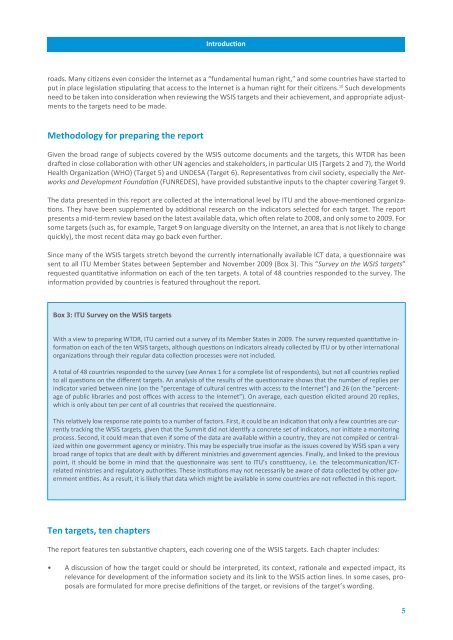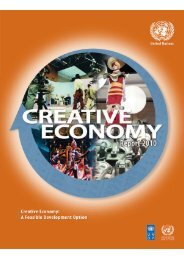Monitoring the WSIS targets
Monitoring the WSIS targets
Monitoring the WSIS targets
- No tags were found...
Create successful ePaper yourself
Turn your PDF publications into a flip-book with our unique Google optimized e-Paper software.
Introductionroads. Many citizens even consider <strong>the</strong> Internet as a “fundamental human right,” and some countries have started toput in place legislation stipulating that access to <strong>the</strong> Internet is a human right for <strong>the</strong>ir citizens. 10 Such developmentsneed to be taken into consideration when reviewing <strong>the</strong> <strong>WSIS</strong> <strong>targets</strong> and <strong>the</strong>ir achievement, and appropriate adjustmentsto <strong>the</strong> <strong>targets</strong> need to be made.Methodology for preparing <strong>the</strong> reportGiven <strong>the</strong> broad range of subjects covered by <strong>the</strong> <strong>WSIS</strong> outcome documents and <strong>the</strong> <strong>targets</strong>, this WTDR has beendrafted in close collaboration with o<strong>the</strong>r UN agencies and stakeholders, in particular UIS (Targets 2 and 7), <strong>the</strong> WorldHealth Organization (WHO) (Target 5) and UNDESA (Target 6). Representatives from civil society, especially <strong>the</strong> Networksand Development Foundation (FUNREDES), have provided substantive inputs to <strong>the</strong> chapter covering Target 9.The data presented in this report are collected at <strong>the</strong> international level by ITU and <strong>the</strong> above-mentioned organizations.They have been supplemented by additional research on <strong>the</strong> indicators selected for each target. The reportpresents a mid-term review based on <strong>the</strong> latest available data, which often relate to 2008, and only some to 2009. Forsome <strong>targets</strong> (such as, for example, Target 9 on language diversity on <strong>the</strong> Internet, an area that is not likely to changequickly), <strong>the</strong> most recent data may go back even fur<strong>the</strong>r.Since many of <strong>the</strong> <strong>WSIS</strong> <strong>targets</strong> stretch beyond <strong>the</strong> currently internationally available ICT data, a questionnaire wassent to all ITU Member States between September and November 2009 (Box 3). This “Survey on <strong>the</strong> <strong>WSIS</strong> <strong>targets</strong>”requested quantitative information on each of <strong>the</strong> ten <strong>targets</strong>. A total of 48 countries responded to <strong>the</strong> survey. Theinformation provided by countries is featured throughout <strong>the</strong> report.Box 3: ITU Survey on <strong>the</strong> <strong>WSIS</strong> <strong>targets</strong>With a view to preparing WTDR, ITU carried out a survey of its Member States in 2009. The survey requested quantitative informationon each of <strong>the</strong> ten <strong>WSIS</strong> <strong>targets</strong>, although questions on indicators already collected by ITU or by o<strong>the</strong>r internationalorganizations through <strong>the</strong>ir regular data collection processes were not included.A total of 48 countries responded to <strong>the</strong> survey (see Annex 1 for a complete list of respondents), but not all countries repliedto all questions on <strong>the</strong> different <strong>targets</strong>. An analysis of <strong>the</strong> results of <strong>the</strong> questionnaire shows that <strong>the</strong> number of replies perindicator varied between nine (on <strong>the</strong> “percentage of cultural centres with access to <strong>the</strong> Internet”) and 26 (on <strong>the</strong> “percentageof public libraries and post offices with access to <strong>the</strong> Internet”). On average, each question elicited around 20 replies,which is only about ten per cent of all countries that received <strong>the</strong> questionnaire.This relatively low response rate points to a number of factors. First, it could be an indication that only a few countries are currentlytracking <strong>the</strong> <strong>WSIS</strong> <strong>targets</strong>, given that <strong>the</strong> Summit did not identify a concrete set of indicators, nor initiate a monitoringprocess. Second, it could mean that even if some of <strong>the</strong> data are available within a country, <strong>the</strong>y are not compiled or centralizedwithin one government agency or ministry. This may be especially true insofar as <strong>the</strong> issues covered by <strong>WSIS</strong> span a verybroad range of topics that are dealt with by different ministries and government agencies. Finally, and linked to <strong>the</strong> previouspoint, it should be borne in mind that <strong>the</strong> questionnaire was sent to ITU’s constituency, i.e. <strong>the</strong> telecommunication/ICTrelatedministries and regulatory authorities. These institutions may not necessarily be aware of data collected by o<strong>the</strong>r governmententities. As a result, it is likely that data which might be available in some countries are not reflected in this report.Ten <strong>targets</strong>, ten chaptersThe report features ten substantive chapters, each covering one of <strong>the</strong> <strong>WSIS</strong> <strong>targets</strong>. Each chapter includes:• A discussion of how <strong>the</strong> target could or should be interpreted, its context, rationale and expected impact, itsrelevance for development of <strong>the</strong> information society and its link to <strong>the</strong> <strong>WSIS</strong> action lines. In some cases, proposalsare formulated for more precise definitions of <strong>the</strong> target, or revisions of <strong>the</strong> target’s wording.5
















